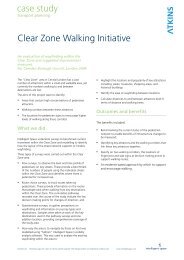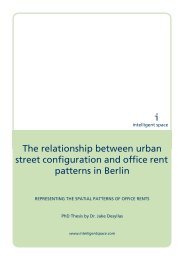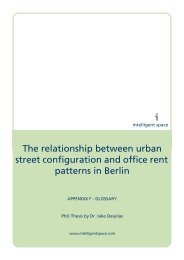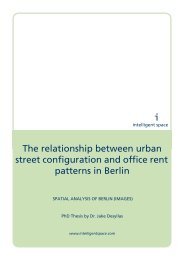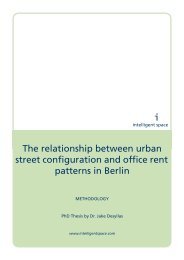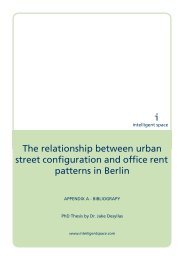Notting Hill Carnival Strategic Review - Intelligent Space
Notting Hill Carnival Strategic Review - Intelligent Space
Notting Hill Carnival Strategic Review - Intelligent Space
You also want an ePaper? Increase the reach of your titles
YUMPU automatically turns print PDFs into web optimized ePapers that Google loves.
entertainment sites and the associated public safety risks of crowd build-up and congestion. The<br />
impact of this work has been clearly evidenced by the partial route change and relocation of the<br />
Judging Point, which was initiated in 2002. Having considered all aspects of the research, its<br />
findings and the views of all stakeholders, it is our recommendation that any future change to the<br />
<strong>Carnival</strong> route must address the issue of public safety and be risk assessed, as far as is possible, in<br />
accordance with the GLA’s <strong>Carnival</strong> Design Guidance. In addition, the guidance should be<br />
developed further in partnership with the <strong>Carnival</strong> Arenas to include the positive work undertaken<br />
by the Caribbean Music Association (CMA) in its ‘On de Road’ code of best practice and the<br />
NHMBA’s ‘Route Management Plan’.<br />
14. Our interim recommendations called for the introduction of a non-circular route and the possible<br />
use of Hyde Park for <strong>Carnival</strong>-related activities. These particular recommendations have been the<br />
subject of much debate and whilst the <strong>Intelligent</strong> <strong>Space</strong> findings provided the catalyst for a partial<br />
route change in 2002, we do not believe that these changes go far enough to reduce crowd<br />
density and ensure public safety. The <strong>Intelligent</strong> <strong>Space</strong> study found that the 2002 route was<br />
unlikely to deliver any gains in public safety, raised serious concerns in relation to the new risks<br />
presented and was unable to provide the level of flexibility required to safely accommodate the<br />
<strong>Carnival</strong>’s future growth. Without a fundamental route change to reduce crowd density and<br />
enhance the cultural spectacle, we do not believe that the <strong>Notting</strong> <strong>Hill</strong> <strong>Carnival</strong> can fulfil its<br />
economic and social potential as a ‘World <strong>Carnival</strong>’. We therefore recommend that:<br />
(a) Hyde Park, the Bayswater Road and the Harrow Road must be considered as part of a new<br />
route for <strong>Carnival</strong> 2005. Such a fundamental change will require detailed discussions and<br />
consultation with all key stakeholders, nevertheless we believe that the <strong>Carnival</strong> Arenas in<br />
partnership with the <strong>Carnival</strong> organisers, should be supported to take ownership and lead on<br />
these discussions to determine their ‘route of the future’; and<br />
(b) the Operational Planning and Safety Group (OPSG) seek additional expert guidance during<br />
the detailed planning and implementation stages of any new route. This will ensure that (i)<br />
all safety issues and implications are identified and addressed at the earliest opportunity; (ii)<br />
risk assessments are kept up to date; and (iii) every assistance is made available to those<br />
stakeholders who experience practical difficulties when implementing recommended risk<br />
reduction measures.<br />
15. Whilst, as a starting point, it is necessary to review the design of the <strong>Carnival</strong> route in order to<br />
make future <strong>Carnival</strong>s safer, we believe that it is also important to review the design of the whole<br />
entertainment area. From a crowd safety viewpoint, the route, the sound systems, and to a lesser<br />
extent, the stalls are all integral and interrelated parts of the <strong>Carnival</strong>. These elements must<br />
therefore be considered together as a package in order reduce crowd density and achieve<br />
increased levels of safety at the <strong>Carnival</strong>. We therefore recommend that in addition to the route,<br />
an assessment of the <strong>Carnival</strong>’s entertainment area should be undertaken with the view of<br />
achieving a safer overall package for future <strong>Carnival</strong>s.<br />
Accountability & Responsibility<br />
16. The <strong>Carnival</strong> Public Safety Matrix offers an analysis of the various roles, responsibilities and tasks<br />
that are delivered by members of the OPSG. We believe that the Matrix clearly demonstrates that<br />
whilst there has always been a community-based organisation to co-ordinate the <strong>Carnival</strong>, the<br />
limitations of this organisation – both in financial and human resource terms – has meant that its<br />
ability to fully assume the role of ‘event organiser’ with responsibility for public safety, has not<br />
been achievable. As a consequence, the evidence suggests that in reality, the MPS, the Royal<br />
Borough of Kensington & Chelsea (RBKC) and the City of Westminster (WCC) have been required<br />
24



